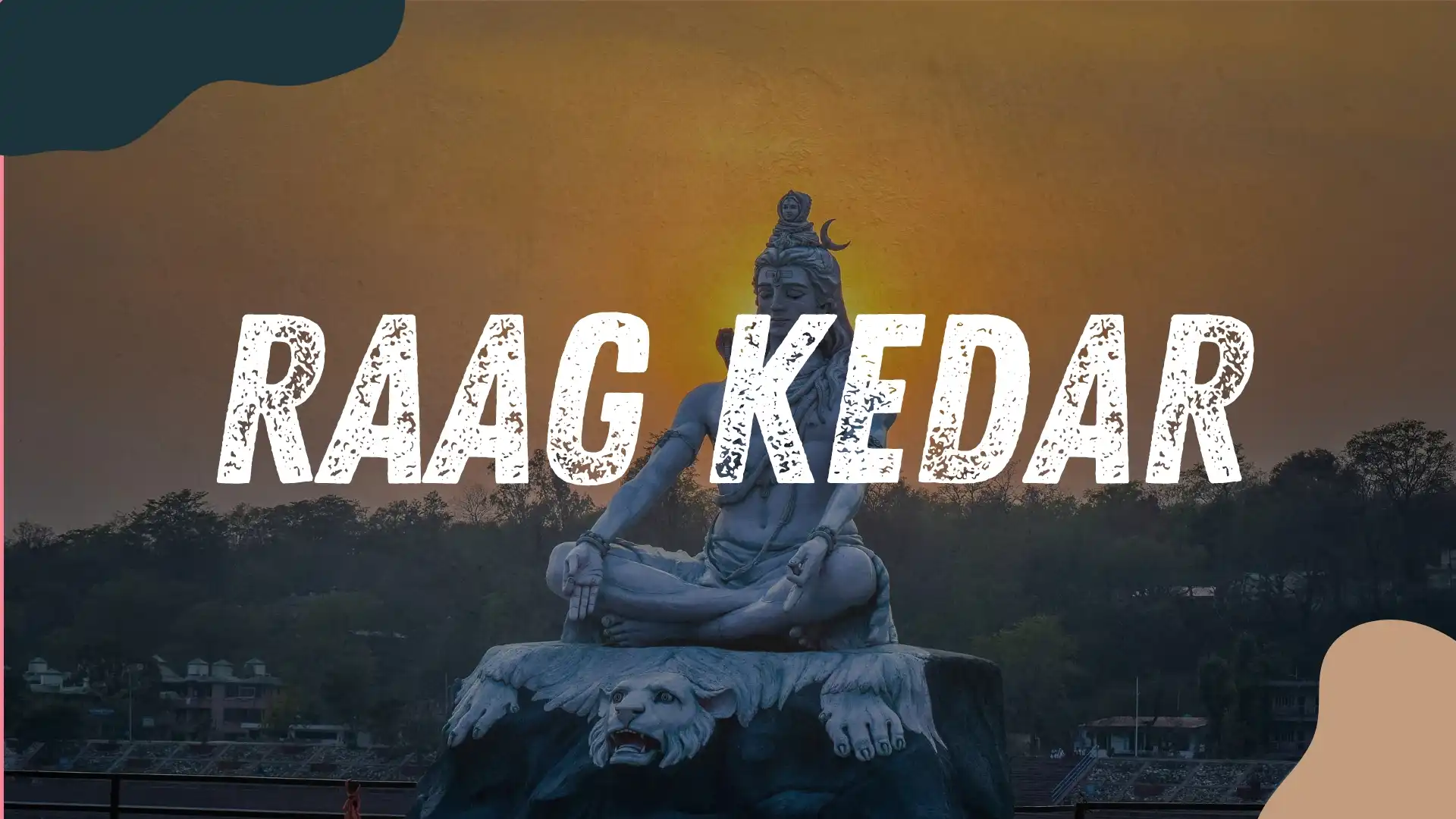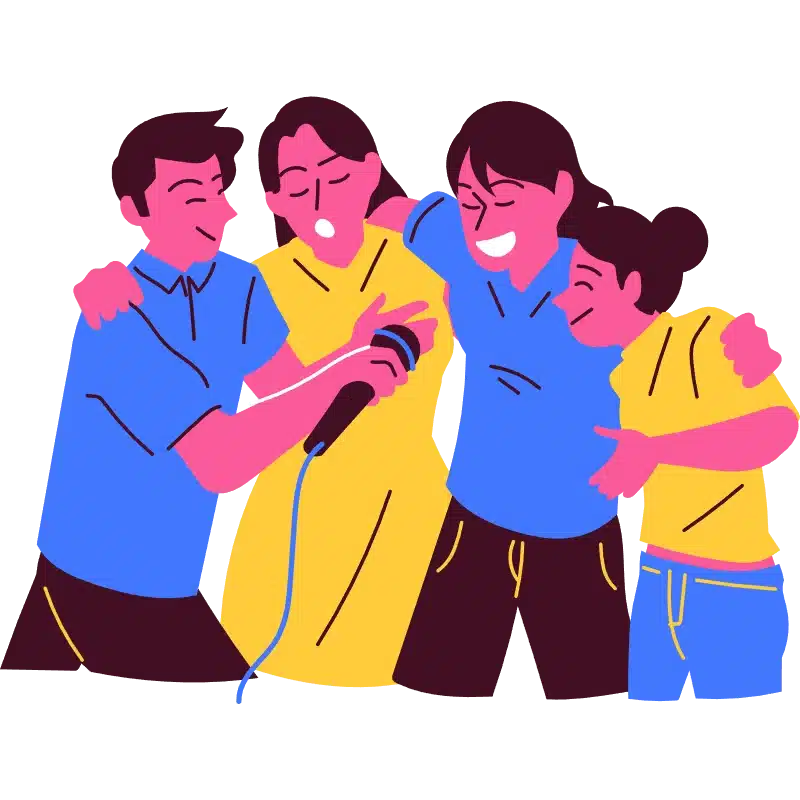Raga Kedar or Raag kedar is also known as Kedara, is a popular Raag in Hindustani Classical Raag originating from Kalyan thaat. Raag Kedar is associated with the rainy season and is of ancient vintage. This Raag is named after Lord Shiva and is loved by Lord Krishna, therefore occupying a high pedestal in Indian Classical Music. Lord Krishna played this raag on his flute, mesmerizing everyone in Gokul.
Over time, Kedar became a popular raah in Hindustani Classical Music, and is often performed in concerts and recordings. It is known for its soulful and meditative quality and is often used to express, from joy and devotion to sadness and longing. Writing in the first quarter of the 20th century, Bhatkhande provides detailed guidelines for the skilful handling of the swar enhancements that Kedar has “recently” accepted.
History & Mood of the Raag Kedar
Raag Kedar has an interesting history that impinges upon its contemporary performance. Whoever created Kedar was clearly blessed with a superior musical intelligence and a receptive heart that beat defenselessly to the powerful vibration of Onkarnaad. The exact origins of Kedar are not clear, but music experts say that going by 16th or 17th century musical treatises, Kedar (which had a somewhat different structure in its medieval avatar) was one of the main raags in the repertoire of Mughal musicians and is said to have been one of the favorite raagsof Mughal Emperor Akbar, who was a great patron of music. The raag is also associated with the legendary Tansen, who was one of the nine gems in Akbar’s court.
In Hindu mythology, Raag Kedar is often associated with Lord Shiva, who is one of the most important deities in the Hindu pantheon. According to legends, Lord Shiva is said to have created the raag and is believed to be its presiding deity. There are several stories that connect Lord Shiva to Raag Kedar.
One of the most popular legends is that Lord Shiva once played the raag on his veena (a musical instrument), and the sound of the raag was so enchanting that it attracted all the living beings in the universe to him. Another legend states that Lord Shiva once appeared to a group of musicians and taught them the raag, which they then passed down through the generations.
The contemporary Kedar would be unconvincing as a representation of the daunting Lord Shiva. Apparently, the melodic enhancements have progressively diluted the raag’s austere aural image, and allowed it to drift towards pronounced Lalitya – a romantic or sensual experience.
Technical details
Raag Kedar is characterized by many melodious turns and is a repetition of Shadaj and Madhyam,which are brilliantly melodious but difficult to express in words. It is generally accepted that it displays much thermal energy and is regarded as the Raagini of Raaag Deepak. While preceding from Shuddha Madhyam to Pancham, a touch of Gandhar or a smooth passage from Gandhar to Pancham expressed as Ma Ga Pa is the more common way of instant raag manifestation.
The Raag is of Shadava-Sampurna nature,i.e., in its aaroh (ascent), only six notes are used, and in avroh (descent), all seven notes are used. In general, the progression of the raag is highly non-linear, which makes it difficult to capture its essence using aaroh and avroh.
The Raag uses only natural (shuddha) versions of the Rishabh, Gandhar and Dhaivat, both natural and sharp (tivra) versions of Madhyam and predominantly natural versions of Nishad but occasionally also its flat or komal. The most prominent note (vadi) is Ma and the second most prominent (samvadi) is Sa.
The meend from Dha to Ma via Pa is the heart of the Raag. This phrase is repeated again and again. The Gandhar is used as a grace note in the transition from Ma to Pa. The movements in the raag from one swara to another are complicated, and the extent of use of the different swaras often depends on the singer. The Raag is to be sung at night. It is sung in the first prahar of night. Most raag with tivra Ma are sung at night (as per the time theory of raag).
Swar Notations
*Throughout the discussion*
*Ma = Shuddha Madhyam, ma = Tivra Madhyam*
*Ni = Shuddha Nishad , ni = Komal Nishad*
| Swaras | Rishabh and Gandhar varjya in Aaroh, Both Madhyams Rest all Shuddha Swaras |
| Jati | Shadava-Sampurna(occasional use of komal Nishad in Avroh and komal Gandhar in Aaroh) |
| Thaat | Kalyan |
| Type (Prakriti) | Chanchal |
| Ideal time to sing | (6 PM- 9PM) ; 1st Prahar of the Night |
| Season | Sung mostly in Rainy Season |
| Vadi / Samvadi | Madhyam / Shadaj |
| Aaroh | Sa Ma, Ma Pa, Dha Pa, Ni Dha Sa’ |
| Avroh | Sa’ Ni Dha Pa, ma Pa Dha Pa Ma, Re Sa |
| Pakad | Sa Ma, Ma Pa, ma Pa Dha Pa Ma, Re Sa |
| Vishranti Sthan | Sa; Ma; Pa – Sa’; Pa; Ma |
Bandish for Practise
To learn the raag from its basics, first we need a better understanding of its chalan that includes aaroh, avroh, pakad and sargam geet. Refer to the audio below to learn the same:
Sargam Geet : Sa Sa Ma Ma
This Sargam Geet is sung in Jhaptaal Madhya laya and starts from sam.
STHAYI
Sa Sa Ma – Ma Ma Ma Pa – Pa
ma Pa Dha Dha Pa ma Pa Ma – Ma
Ma Ma Pa – Pa Sa’ Ni Dha Dha Pa
ma Pa Dha ma Pa Ma Ma Re Re Sa
ANTARA
Pa Pa Sa’ – Sa’ Dha Dha Sa’ Re’ Sa’
Sa’ Ni Dha Sa’ Re’ Sa’ Ni Dha Pa Ma
Ma Ma Pa – Pa Sa’ Ni Dha Dha Pa
ma Pa Dha ma Pa Ma Ma Re Re Sa
Bandish 1 : Sharan Prabhu Ke
Lyrics of the bandish taught above are as follows:
STHAYI
Sharan Prabhu Ke Dwar Aaj Hu
Sharan Prabhu Ke Dwar Aaj Hu
Shuddha Bhaav Su Bhajan Karu Mai
Prabhu Sab Ke Aadhar Aaj Hu
ANTARA
Shuddha Suran Ko Mel Milau
Taame Madhyam Ansh Rachau
Gupta Gandhar Rikhab Bin Rohan
Reejhe Prabhu Kartar Aaj Hu
Bandish 2 : Soch Samajh Man Meet
This Bandish is sung in teen taal madhya laya and starts from Khali.
STHAYI
Soch Samajh Man Meet Piyarva -2
Sadguru Naam Kare Sumiranva -2
ANTARA
Ghari Ghari Pal Pal Umar Ghatat Sab -2
Ajahu Chet Mati Mand Chaturva
TAAN
STHAYI
1. Sa Re Sa Sa Ma Ma Re Sa Pa Pa ma Pa Ma Ma Re Sa
2. Sa Sa Ma Ma Pa Pa ma Pa Dha Pa ma Pa Ma Ma Re Sa
3. ma ma Pa Pa Dha Dha Pa Pa ma Pa Dha Pa Ma Ma Re Sa
4. Ma Ma Re Sa Pa Pa ma Pa Ma Ma Re Sa Dha Dha Pa Pa
Ma Ma Re Sa Sa’ Ni Dha Pa ma Pa Dha Pa Ma Ma Re Sa
5. Sa Re Sa Sa Pa Dha Pa Pa Sa’ Re Sa’ Ni Dha Pa ma Pa
ma Pa Dha ni Dha Pa ma Pa ma Pa Dha Pa Ma Ma Re Sa
ANTARA
1. ma Pa Dha ni Dha Pa ma Pa Sa Sa Ma Ma Pa Pa ma Pa
2. ma Pa Dha Ni Sa’ Ni Dha Pa ma Pa Dha Pa Ma Ma Re Sa
Dha ma Ma Pa Sa Ma Pa Pa ma Pa Dha Pa Dha Ni Sa’-
3. Dha Pa ma Pa Sa’ Re’ Sa’ Ni Dha Pa ma Pa Re’ Re’ Sa’ Ni
Dha Pa ma Pa ma Pa Dha Ni Dha Pa ma Pa Dha Ni Sa’-
Bandish 3 : Kanha Re
Kanha Re is quite a famous bandish of raag kedar, sung in teen taal madhya laya and starts from the 13th beat. Lyrics are as follows:
STHAYI
, – Kanha
Re- – – Nand Nandan , Param -2
Niranjan Hey Dukh Bhanjan
ANTARA
Kanth Mani Motiyan Ki Mala -2
Pahirat Mudit Bhayi Brij Bala
Variants and equivalents of the Raag Kedar
Traditionally, four types of Kedar are recognized by Bhatkhande’s Sangeet Paddhati and they are Shuddha Kedar, Chandni Kedar, Maluha Kedar and Jaladhar Kedar. Over the course of years or so, several new types have entered the fold, out of which most are jod-ragas ,i.e., hybrids, formed by combining Kedar with other melodies. Some of the other variants of Kedar are Adambari Kedar, Anandi Kedar, Basanti Kedar, Deepak Kedar, Kedar Bahar, Kedari Malhar, Nat Kedar, Shyam Kedar and Tilak Kedar.
Kedar is one of the five raags that form the Kalyan Panchak or Panchya with Hameer, Gaud Sarang, Kamod, Chaayanat and Kedar. These four raags are often considered equivalents of Kedar. This is because they share similar melodic phrases, musical structures and emotional mood or sentiment (rasa) as Kedar. Kedar is an ancient raag, with different genres of classical songs like khayals, thumris, dhrupads, as well as light classical songs based on it. The Carnatic equivalent of Kedar is said to be Hamir Kalyani which is janya of the 65th Melakarta Ragam “Kalyani”.
Why it is called Raag Kedar
There are different theories about how Raag Kedar got its name. One theory is that the raag is named after Lord Shiva, who is also known as Kedarnath. The Kedarnath temple, located in the state of Uttarakhand in India, is one of the twelve Jyotirlingas (sacred abodes of Lord Shiva) and is associated with the legend of the Pandavas from the Hindu epic Mahabharata. It is believed that the raag was first performed in this temple, which is why it was named after Lord Shiva as Kedar.
Another theory is that the raag is named after the Kedar range of mountains in the Himalayas, which is also associated with Lord Shiva and is considered to be a sacred site for Hindus. According to this theory, the raag was created in the Himalayan region and was inspired by the natural beauty and spiritual energy of the mountains.
Regardless of its origin, this Raag is considered to be a powerful and spiritually uplifting raag in the Hindustani classical music tradition, and is often used in devotional music and religious ceremonies. Its association with Lord Shiva and the Himalayas adds to its spiritual significance and makes it a popular and widely revered raag among musicians and music lovers. Overall, the connection between Raag Kedar and Lord Shiva is an important part of Hindu mythology and highlights the deep spiritual significance of music in the Hindu tradition.
Raag Kedar’s significance in Sikhism
This raag has a significant place in the sikh religion and is an important part of the holy Guru Granth Sahib, which is the central religious scripture of Sikhism. As we know, Kedar is an old raag dating from the time of Shiva and passing on the raag was also used by few of the Ten Gurus of Sikhs including Guru Ram Das Ji, Guru Arjan Dev Ji and some other saints of that time including Saint Kabir Das Ji and Saint Ravidas Ji for a few short hymns and poems.
This raag is one of the 31 raag used in the Guru Granth Sahib, and is also associated with the Sikh holy scripture known as the Shabad Kirtan, which is the singing of hymns from the Guru Granth Sahib accompanied by musical instruments. In Sikhism, Kedar Raag is associated with the mood of devotion and longing for the divine. The raag is believed to connect the listener with the divine and experience a sense of spiritual ecstasy. The lyrics of the hymns sung in raag kedar often focus on the love and devotion of the devotee towards God, and convey a sense of surrender and humility.
According to the Guru Granth Sahib, This Raag expresses and makes the mind aware of the soul’s true character. It conveys the emotions of honesty, integrity and truthfulness in a practical and caring way. This approach is memorable, so that the mind is made aware, without arousing cynicism.
Famous bollywood & other related compositions on Raag Kedar
In Bollywood, several of the great music composers have used this raag to depict a wide range of emotions of worship as well as shades of love. One of the songs that truly explains the essence of the raag is Darshan Do Ghanshyam Nath from the movie Narsi Bhagat in 1957.
Another great piece is from the film Guddi written by Gulzar and set to music by Vasant Desai. The Director Hrishikesh Mukherjee wanted to use a Rabindra Sangeet but at the insistence of Vasant Desai, he reluctantly sat down to listen to Vani Jairam. The result was the gem Humko Man Ki Shakti Dena set in Kedar which has since then been adopted by many schools as their prayer song. Some of the other popular songs in Raag Kedar are Aapki Aankho Mein Kuch
from the movie Ghar, Aap Yuhi Agar Humse Milte Rahe from the movie Ek Musafir Ek Hasina, Pal Do Pal Ka Sath Humara from the movie The Burning Train.
Onward now to the classical arena, a couple of pickings from Gwalior Gharana serve to introduce the khayal treatment. D.V. Paluskar sings the traditional bandish, Jogia Ja and the druta composition features the chestnut Kanha Re Nanda Nandana starting from 12:30 seconds. Another popular traditional masterpiece is Kanganwa mora atahi amola by Malini Rajurkar. Listen to Bade Ghulam Ali Khan’s masterpiece Sabrang in Kedar.
In addition to these masterpieces, there are also many devotional songs and hymns dedicated to Lord Shiva that are based on this Raag. These songs are often performed during religious ceremonies and festivals in honour of Lord Shiva.
Related blog: Raagam Thalam Sruthi































